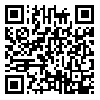Volume 68, Issue 9 (6 2010)
Tehran Univ Med J 2010, 68(9): 534-540 |
Back to browse issues page
Download citation:
BibTeX | RIS | EndNote | Medlars | ProCite | Reference Manager | RefWorks
Send citation to:



BibTeX | RIS | EndNote | Medlars | ProCite | Reference Manager | RefWorks
Send citation to:
S N, B J, AR S, E S, A T, R T et al . The role of group A beta hemolytic streptococcal infections in patients with tic and tourett's disorders. Tehran Univ Med J 2010; 68 (9) :534-540
URL: http://tumj.tums.ac.ir/article-1-314-en.html
URL: http://tumj.tums.ac.ir/article-1-314-en.html
Noorbakhsh S * 
 1, Jalili B
1, Jalili B 
 , Shamshiri AR
, Shamshiri AR 
 , Shirazi E
, Shirazi E 
 , Tabatabaei A
, Tabatabaei A 
 , Taghipour R
, Taghipour R 
 , Modares Fathi A
, Modares Fathi A 


 1, Jalili B
1, Jalili B 
 , Shamshiri AR
, Shamshiri AR 
 , Shirazi E
, Shirazi E 
 , Tabatabaei A
, Tabatabaei A 
 , Taghipour R
, Taghipour R 
 , Modares Fathi A
, Modares Fathi A 

1- , samileh_noorbakhsh@yahoo.com
Abstract: (17364 Views)
Background: Recently, many cases diagnosed as pediatric autoimmune
neuropsy-chiatric disorders associated with group A beta hemolytic streptococcus infection (PANDAS) due to production of
autoimmune antibodies. Object of this study was comparison the titer of
antibodies against group A beta
hemolytic streptococcus (ASOT,
Anti-DNase B, and Anti streptokinase) between children with
movement disorders (tic and tourett's
disorders pediatric autoimmune psychiatric disorders) and healthy control.
Methods: A cross sectional/ cases control study in pediatric neuropsychology ward and clinics in two referral hospitals (Rasoul & Aliasghar) affiliated by IUMS had done in Tehran, Iran (2008-2010). We selected 53 children with tic disorder and 76 healthy controls (age matched children). The antibody titers (IU/ml) in their area were compared and analyzed statistically. The area under ROC, sensitivity, specificity and positive predictive value of tests calculated.
Results: Age of cases was between 4-16 years. All antibody titers had significant difference between two groups (p<0.0001 p=0.05 p=0.002 for ASOT, Anti-DNase and Antihyaloronidase respectively). ASOT (cut off level> 200IU/ml) had 75% sensitivity 84% specificity and 80% PPV Anti- streptokinase (cut off level> 332IU/ml) had 34% sensitivity 85% specificity, and 90% PPV Anti-DNase (cut off level> 140IU/ml) had 70% sensitivity 99% specificity and PPV 90%.
Conclusion: Patients with tic disorder had a significant high antibody titer against streptococcal infection in comparison with healthy children. It presents possible role for streptococcal infection in tic disorders. Treatment of streptococcal infection is achievable by using of long acting Penicillin in our country. Use of aggressive treatment like plasmaphresis etc needs future RCT studies.
Methods: A cross sectional/ cases control study in pediatric neuropsychology ward and clinics in two referral hospitals (Rasoul & Aliasghar) affiliated by IUMS had done in Tehran, Iran (2008-2010). We selected 53 children with tic disorder and 76 healthy controls (age matched children). The antibody titers (IU/ml) in their area were compared and analyzed statistically. The area under ROC, sensitivity, specificity and positive predictive value of tests calculated.
Results: Age of cases was between 4-16 years. All antibody titers had significant difference between two groups (p<0.0001 p=0.05 p=0.002 for ASOT, Anti-DNase and Antihyaloronidase respectively). ASOT (cut off level> 200IU/ml) had 75% sensitivity 84% specificity and 80% PPV Anti- streptokinase (cut off level> 332IU/ml) had 34% sensitivity 85% specificity, and 90% PPV Anti-DNase (cut off level> 140IU/ml) had 70% sensitivity 99% specificity and PPV 90%.
Conclusion: Patients with tic disorder had a significant high antibody titer against streptococcal infection in comparison with healthy children. It presents possible role for streptococcal infection in tic disorders. Treatment of streptococcal infection is achievable by using of long acting Penicillin in our country. Use of aggressive treatment like plasmaphresis etc needs future RCT studies.
Keywords: Group A streptococcus, Pediatric Autoimmune Neuropsychiatric Disorder, PANDAS, tic disorders, tourett’s syndrome
Send email to the article author
| Rights and permissions | |
 |
This work is licensed under a Creative Commons Attribution-NonCommercial 4.0 International License. |



